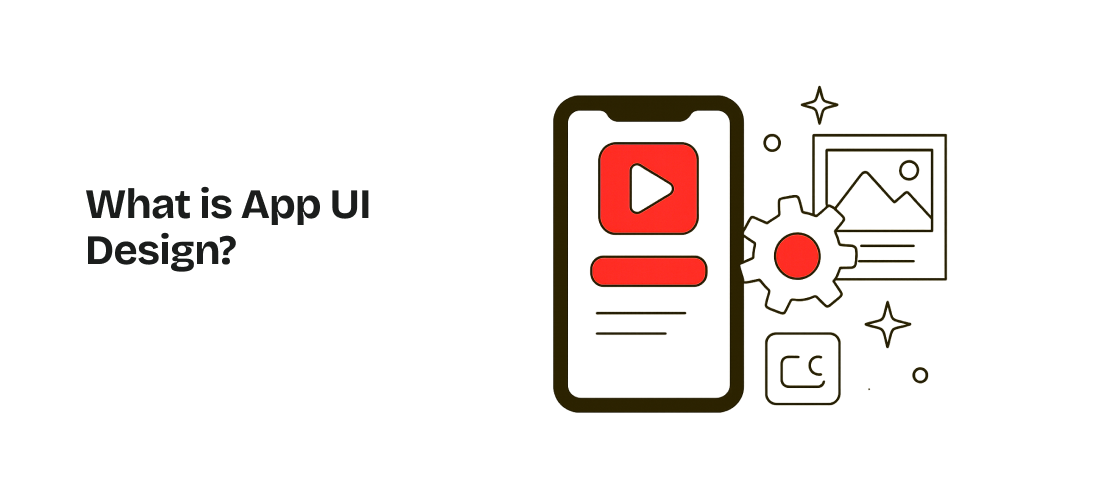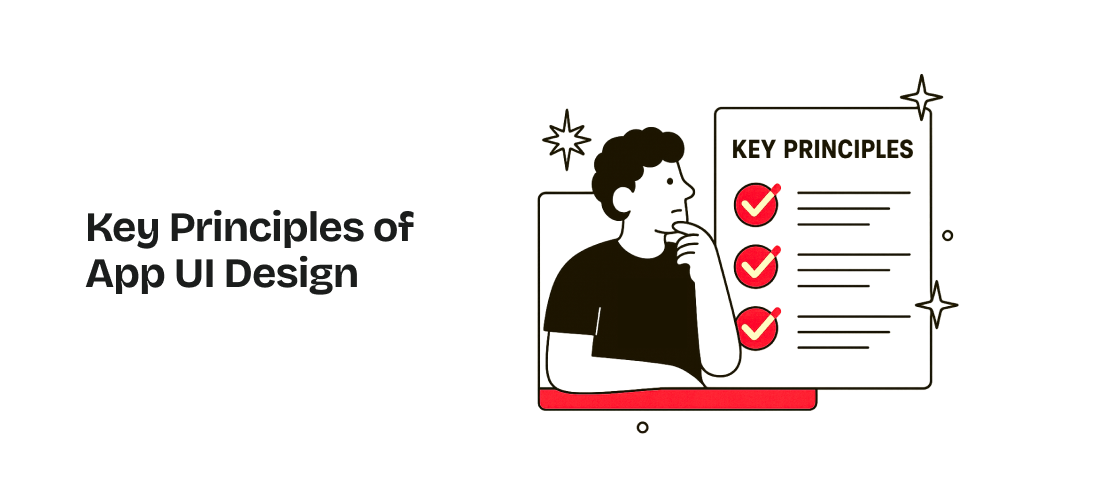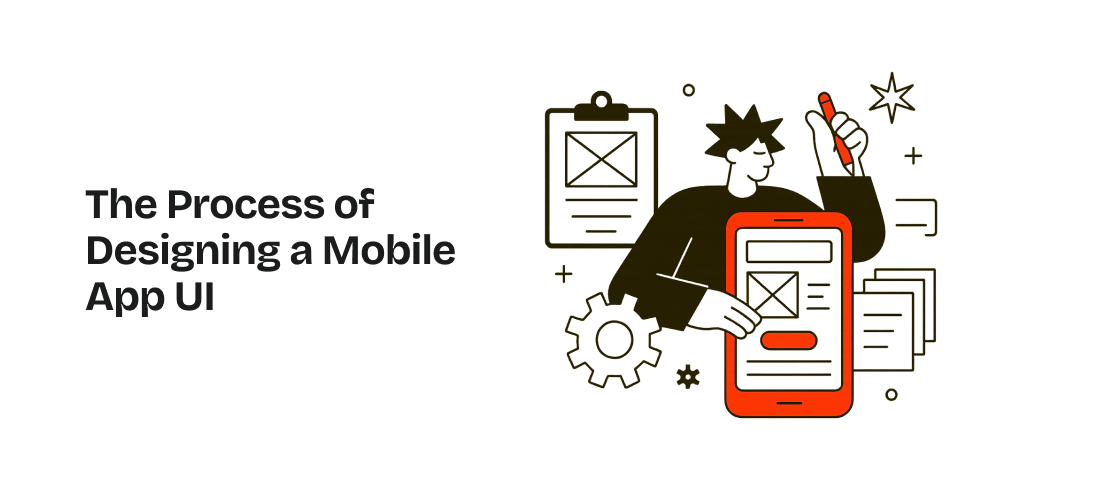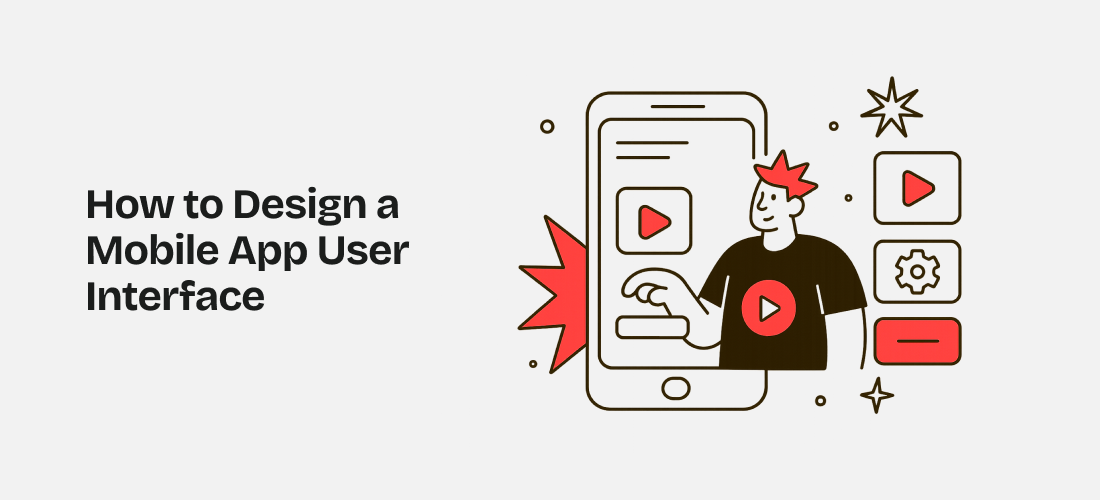The success of any mobile app hinges on its ability to deliver a seamless and engaging user experience. Central to this experience is the app’s user interface (UI), which bridges the user and the app’s functionality. App UI design is about creating an intuitive and efficient interface that enhances the user’s interaction with the app. Here, we will explore the fundamentals of app UI design, the essential principles to follow, and the step-by-step process of designing a mobile app user interface that meets user needs and business goals.
What is App UI Design?

App UI design refers to the process of designing the user interface of a mobile application. It involves creating the app’s visual elements and defining how these elements interact with each other and the user. These elements include buttons, icons, typography, color schemes, and layouts. App UI design helps create an intuitive, efficient, and visually appealing interface, allowing users to interact easily with the app’s features and content.
Mobile app UI design is a critical aspect of app development that directly impacts user satisfaction, engagement, and retention. A well-designed UI makes an app visually appealing and ensures users can navigate and interact with the app effortlessly. A poorly designed UI can lead to high abandonment rates and negative reviews. Conversely, a thoughtfully designed UI can significantly enhance the overall user experience, making the app more enjoyable and functional.
The Role of UI Design in Mobile App Development
The UI design plays a crucial role in mobile app development for several reasons:
- First Impressions Matter: The UI is the first thing users see when they open an app. A well-designed UI can create a positive first impression, encouraging users to explore the app further, while a poorly designed UI can lead to immediate abandonment.
- Enhancing Usability: The primary purpose of app UI design is to make the app easy to use. A well-designed UI ensures that users can quickly understand how to navigate the app, access features, and complete tasks without confusion.
- Building Brand Identity: The UI design is an extension of a brand’s identity. Consistent use of colors, fonts, and design elements helps reinforce brand recognition and creates a cohesive brand experience across all platforms.
- Driving User Engagement: An engaging UI design can keep users interested in the app, encouraging them to spend more time exploring its features. This can lead to higher user retention rates and increased customer loyalty.
- Improving Accessibility: A well-designed UI considers the needs of all users, including those with disabilities. By adhering to accessibility guidelines, designers can create interfaces that are usable by a wider audience.
Key Principles of App UI Design

Designing a mobile app UI requires adherence to certain principles that ensure the interface is functional, user-friendly, and visually appealing. Here are some of the key principles to keep in mind:
1. Simplicity
Simplicity is a fundamental principle of app UI design. A simple design minimizes cognitive load and makes it easier for users to navigate the app and perform tasks. This doesn’t mean stripping the app of essential features but rather presenting information and options in a clear and concise manner.
How to Achieve Simplicity:
- Minimize Clutter: Avoid overwhelming users with too many elements on a single screen. Prioritize the most important features and information, and use whitespace effectively to create a clean layout.
- Streamline Navigation: Simplify navigation by limiting the number of steps required to complete a task. Use familiar navigation patterns, such as bottom navigation bars or hamburger menus, to make it easy for users to find what they need.
- Use Clear Labels and Icons: Ensure that all buttons, icons, and labels are clearly defined and easy to understand. Avoid jargon or complex language that could confuse users.
2. Consistency
Consistency in app UI design is key to creating a seamless user experience. Consistent design elements, such as colors, fonts, and button styles, help users build familiarity with the app, reducing the learning curve and making navigation more intuitive.
How to Maintain Consistency:
- Design Guidelines: Establish design guidelines that outline the use of colors, typography, icons, and other elements. Ensure that these guidelines are applied consistently across all screens and features of the app.
- Repetitive Patterns: Use repetitive design patterns for similar functions. For example, if a certain action is represented by a specific button style on one screen, use the same style for similar actions on other screens.
- Platform Conventions: Adhere to the design conventions of the platform (iOS or Android) to maintain consistency with user expectations. Each platform has its own design guidelines, such as Apple’s Human Interface Guidelines and Google’s Material Design.
3. Feedback and Responsiveness
Providing feedback to users is essential for keeping them informed about the status of their interactions with the app. Feedback can be visual, auditory, or haptic and should be provided in response to user actions, such as tapping a button, submitting a form, or waiting for a process to complete.
How to Provide Effective Feedback:
- Visual Cues: Use visual cues, such as color changes, progress indicators, or animations, to indicate that an action has been recognized and processed. For example, a button could change color when pressed, or a loading spinner could appear while a page is loading.
- Error Messages: Provide clear and concise error messages when something goes wrong. The message should explain the issue and offer guidance on how to resolve it.
- Success Confirmation: When a task is completed successfully, provide a confirmation message or visual feedback to reassure the user that their action was successful.
4. Accessibility
Accessibility is about making your app usable by as many people as possible, including those with disabilities. By following accessibility best practices, you can create an inclusive app that caters to a wider audience.
How to Enhance Accessibility:
- Text Size and Contrast: Ensure that text is large enough to be read comfortably on all devices and that there is sufficient contrast between text and background colors to aid readability.
- Alternative Text for Images: Provide alternative text for images, icons, and other non-text elements to assist users who rely on screen readers.
- Touch Targets: Make sure that touch targets (e.g., buttons, links) are large enough to be easily tapped, especially for users with motor impairments.
- Voice Commands: Consider integrating voice commands or voice-over features to enhance accessibility for users with visual or motor impairments.
5. Visual Hierarchy
Visual hierarchy refers to the arrangement of elements in a way that guides users’ attention to the most important content first. By establishing a clear visual hierarchy, you can help users quickly understand the structure of the app and easily find the information they need.
How to Create Visual Hierarchy:
- Size and Weight: Use size and weight to emphasize important elements. For example, headings should be larger and bolder than body text, and primary buttons should be more prominent than secondary buttons.
- Color and Contrast: Use color and contrast to highlight key actions or information. For instance, a call-to-action button could be a bright color that stands out against the background.
- Spacing and Alignment: Use spacing and alignment to group related elements and create a logical flow of information. Proper use of whitespace can make the layout more readable and less cluttered.
6. User-Centered Design
User-centered design (UCD) is an approach that places the needs, preferences, and behaviors of the user at the center of the design process. By focusing on the user, you can create an app UI that is intuitive, enjoyable, and tailored to the target audience.
How to Implement User-Centered Design:
- User Research: Conduct user research to understand your target audience’s needs, pain points, and behaviors. This can include surveys, interviews, and usability testing.
- Personas: Develop user personas that represent different segments of your audience. Use these personas to guide design decisions and ensure that the app meets the needs of different user groups.
- Usability Testing: Regularly test the app with real users throughout the design and development process. Gather feedback and make adjustments based on their experiences to improve usability.
The Process of Designing a Mobile App UI

Designing a mobile app UI involves several stages, from initial concept to final implementation. Here’s a step-by-step overview of the process:
1. Research and Planning
The first step in the app UI design process is to conduct research and create a plan. This stage involves understanding the target audience, defining the app’s goals and objectives, and gathering inspiration from competitors and industry trends.
Key Activities:
- Audience Analysis: Identify the demographics, needs, and preferences of your target audience. This will inform your design decisions and ensure that the app meets user expectations.
- Competitor Analysis: Study competitors’ apps to identify strengths and weaknesses in their UI design. Use this information to differentiate your app and avoid common pitfalls.
- Goal Setting: Define the primary goals and objectives of the app. What problem does the app solve? What actions do you want users to take? These goals will guide the design process.
2. Wireframing
Wireframing is the process of creating a low-fidelity, skeletal representation of the app’s layout and structure. Wireframes outline the placement of UI elements, such as buttons, menus, and content, without focusing on visual details.
Key Activities:
- Layout Design: Create wireframes for each screen of the app, defining the basic layout and structure. Focus on the arrangement of elements and the flow of user interactions.
- Navigation Flow: Map out the navigation flow between screens, ensuring that users can easily move between different sections of the app.
- Feedback and Iteration: Share wireframes with stakeholders and gather feedback. Make revisions as needed to refine the layout and structure.
3. Prototyping
Prototyping involves creating a more detailed, interactive version of the app’s UI. Prototypes simulate the user experience by allowing users to interact with the interface, test navigation, and explore features.
Key Activities:
- High-Fidelity Design: Develop high-fidelity prototypes that include detailed design elements, such as colors, typography, and images. Ensure that the prototype closely resembles the final product.
- Interactive Elements: Add interactive elements to the prototype, such as clickable buttons, swipe gestures, and animations. This allows users to experience the app’s functionality.
- Usability Testing: Conduct usability testing with the prototype to identify any issues or areas for improvement. Use feedback to make refinements before moving on to development.
4. Visual Design
The visual design stage is where the app’s final look and feel are created. This involves applying the brand’s visual identity, such as colors, fonts, and imagery, to the UI elements.
Key Activities:
- Color Scheme: Choose a color scheme that reflects the brand’s identity and enhances the user experience. Use colors consistently across the app to create a cohesive look.
- Typography: Select fonts that are readable and align with the brand’s personality. Ensure that typography is consistent across all screens.
- Iconography: Design or select icons that are intuitive and visually appealing. Icons should be easily recognizable and enhance the user’s understanding of the app’s features.
5. Development and Implementation
Once the visual design is complete, the app UI is handed off to mobile app developers for implementation. The development team will bring the design to life by coding the interface and integrating it with the app’s backend functionality.
Key Activities:
- Design Handoff: Provide developers with detailed design specifications, including layout dimensions, color codes, font sizes, and interactive behaviors. Use design tools like Figma or Sketch to facilitate the handoff.
- Collaboration: Work closely with developers to ensure that the design is implemented accurately. Address any technical challenges or constraints that arise during development.
- Quality Assurance: Conduct thorough testing to ensure that the UI functions as intended across all devices and platforms. Make any necessary adjustments to address bugs or performance issues.
6. Launch and Post-Launch
After the app is developed and tested, it is ready for launch. However, the design process doesn’t end there. Post-launch, it’s important to gather user feedback, monitor performance, and make continuous improvements to the UI.
Key Activities:
- User Feedback: Collect feedback from users after the app is launched. Use surveys, reviews, and analytics to identify areas for improvement.
- Performance Monitoring: Monitor the app’s performance, including load times, responsiveness, and user engagement. Address any issues that affect the user experience.
- Updates and Enhancements: Based on user feedback and performance data, make updates and enhancements to the UI. Regularly release new versions of the app to keep it fresh and relevant.
Conclusion
By sticking to key app UI design principles—like keeping things simple, consistent, responsive, accessible, and user-focused—you can build an interface that provides a smooth and engaging experience. The step-by-step guide in this blog, from initial research and planning to development and post-launch, offers a clear path for designing a mobile app UI that meets both user needs and business goals.






